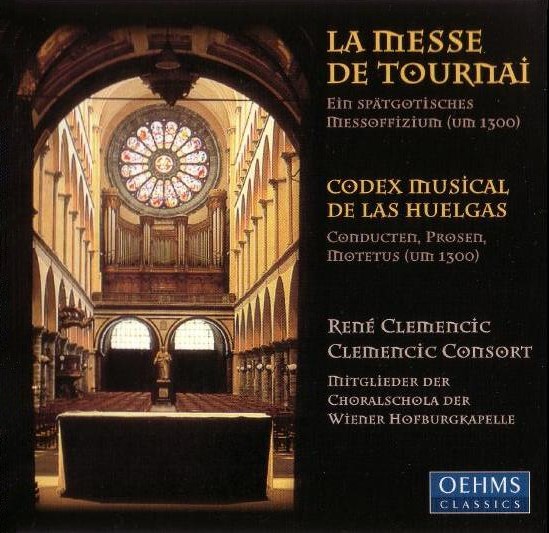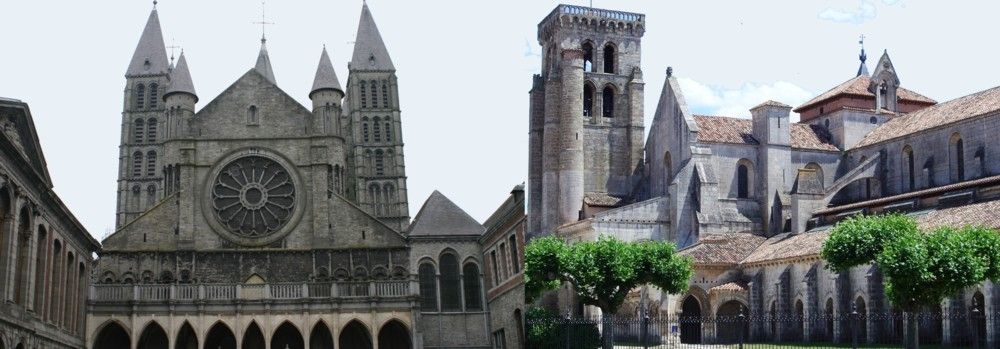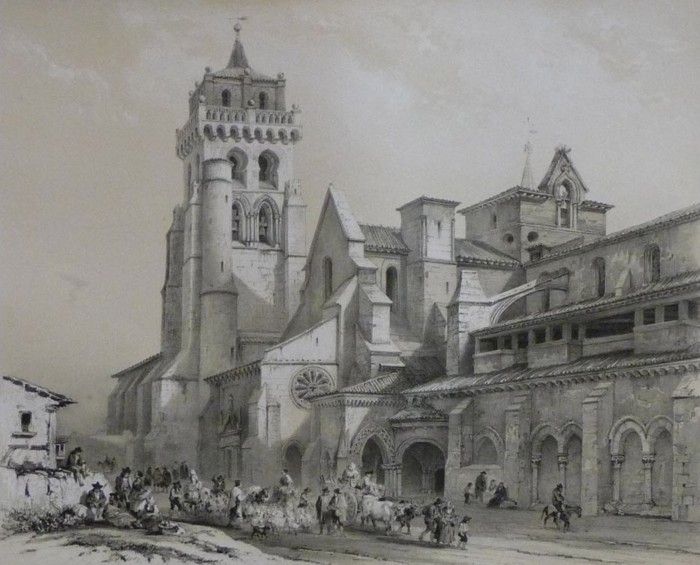Clemencic Consort · Choralschola der Wiener Hofburgkapelle
La Messe de Tournai. Ein spätgotisches Messoffizium (um 1300)
Codex Musical de las Huelgas. Conducten, Prosen, Motetus (um 1300)

medieval.org
oehmsclassics.de
Oehms Classics OC 361
2003 (p.2005)
Missa
de Tournai
Codex Las
Huelgas
1. Catholicorum concio [1:39]
organ
2. Introitus. Rorate coeli [0:53]
cantus
3. Conductus XI. Parens patris, natique filia [3:07]
instrumental
4. Kyrie - Christe - Kyrie [2:21]
5. Gloria [6:52]
6. Motetus LI. Ave, caro splendida ~ Salve salus [1:38]
instrumental
7. Graduale. Tollite portas [1:41]
cantus
08. Benedicamus IV [0:59]
organ
9. Credo [4:21]
10. Prosa XXIII. Virgines egregiae [2:24]
organ
11. Sanctus - Benedictus [2:24]
12. Benedicamus XI. Benigno voto [2:20]
organ
13. Agnus Dei [1:25]
14. Communio. Ecce Virgo [0:51]
cantus
15. Conductus XVIII. Si vocatus ad nuptias [1:53]
organ
16. Ite Missa est ~ Se grasse Nest ~ Cum venerint [1:49]
17. Flos vernalis(c. 1300) [2:05]
organ
18. Motetus LIX. Mellis stilla [1:32]
instrumental
19. Prosa. In virgulto gracie [2:41]
20. Sanctus VI. Divinum mysterium [1:57]
instrumental
21. Prosa. Salve Regina glorie [3:36]
22. Prosa VI. Aeterni numinis mater [5:18]
instrumental
23. Motetus. Salve virgo ~ Ave gloriosa ~ DOMINO [4:29]
24. Philippe de VITRY. Motetus instrumental [2:39]
Clemencic Consort
Thomas Künne - Countertenor
Bernd Oliver Fröhlich, Bernd Lambauer - Tenor
Mario Eder - Baß
William Dongois, Zink
Mitglieder der Choralschola der Wiener Hofburgkapelle
René Clemencic, Spätgotisches Orgelpositiv
& künstlerische Leitung
Executive Producer: Dieter Oehms
Recorded October 25-27, 2003, W*A*R-Studio Wie
Recording Producers & Sound Engineers: Elisabeth & Wolfgang Reithofer
Editing & Mastering: Wolgang Reithofer

Die Kathedrale von Tournai in Belgien zählt zu den
beeindruckendsten und bedeutendsten Kirchenbauwerken Europas, sie
gehört zum Weltkulturerbe der UNESCO. An diesem Ort wurde
Musikgeschichte geschrieben: In der Bibliothek findet sich das
Manuskript eines Ordinarium Missae, entstanden um das Jahr 1300, das
Stücke verschiedener Komponisten und Stile vereint. Damit ist sie
ein direkter Wegbereiter zu den ersten zusammengehörigen, aus
einer Hand stammenden Messe-Kompositionen wie der Messe de Nostre Dame
von Guillaume de Machaut.
René Clemencic, der große Musikforscher und Interpret
mittelalterlicher Musik, ergänzte die Messe de Tournai mit ein-
und mehrstimmigen Stücken aus dem spanischen Codex Musical de las
Huelgas. Gemeinsam mit den Musikern des Clemencic Consorts wird hier
eine musikalische Epoche lebendig, die uns heute mit ihrer
stilistischen Vielfalt und ihrer Lust an musikalischen Entdeckungen
fasziniert.
LA MESSE DE TOURNAI
CODEX MUSICAL DE LAS HUELGAS
Es wird hier versucht, ein Offizium Missae aus der ersten Hälfte
des 14. Jahrhunderts wiederzugeben. Im Mittelpunkt steht ein
mehrstimmiges Ordinarium Missae um 1300, welches in einer Handschrift
der Kathedrale von Tournai in Belgien erhalten ist. Der Kopist, der
Schreiber der Kathedrale, hat dabei Stücke verschiedener
Komponisten, und auch verschiedener Epochen und Stile in einem einzigen
Manuskript vereinigt. Diese Vereinheitlichung scheint einem damals
langsam entstehenden Bedürfnis nach einem geschlossenen polyphonen
Ordinarium zu entsprechen. Wirklich durchgesetzt haben sich diese
Tendenzen erst in der zweiten Hälfte des 15. Jahrhunderts. Bereits
Ende des 14. Jahrhunderts aber scheint ein einziger Komponist,
Guillaume de Machault, diese kompositorische Einheit angestrebt zu
haben, ohne dass diese Tendenz in der Praxis unmittelbar nach Machault
wirklich konsequent und durchgehend realisiert wurde.
Kyrie, Sanctus und Agnus der „Messe de
Tournai“ scheinen stilistisch noch dem Ende des 13. Jahrhunderts
anzugehören. Die Rhythmik ist noch die modale Gruppenrhythmik. Das
syllabische Credo ist dem Conductus nahestehend. Das recht bewegte Gloria
zeigt eine gewisse Nähe zum Motetus, ohne wirklich einer zu sein.
Das Amen des Gloria macht Gebrauch von der die
Melodielinien zerreißenden Hoquetus (Schluckauf)-Technik. Das
dreistimmige Ite missa est ist ein zweisprachiger Motetus.
Spätmittelalterliche Vereinigung des Widersprüchlichen,
Einheit des Heterogenen, akustische Gleichzeitigkeit verschiedener
Welten. Das Triplum, die erste Stimme, singt ein französisches
Liebeslied, die zweite Stimme, der Motetus, einen lateinischen,
moralisierenden Text, und der Tenor zitiert ein Bruchstück einer
gregorianischen Melodie in isorhythmischer Technik. Das heißt,
ein rhythmisches Modell wird einmal (wie hier) oder mehrmals wiederholt.
Ergänzend zum mehrstimmigen Ordinarium Missae lassen wir
einstimmige, gregorianische Melodien des Proprium Missae erklingen
sowie eine Reihe ein- und mehrstimmiger geistlicher Werke in vokaler
oder instrumentaler Version, wie man sie in den feierlichen
Gottesdiensten hören konnte.
Es handelt sich dabei, mit der Ausnahme des Motetus von
Philippe de Vitry, um Stücke aus dem Codex Musical de las Huelgas.
Der um 1300 in Spanien entstandene Codex stellt eine wichtige Quelle
europäischer Mehrstimmigkeit zu Beginn des 14. Jahrhunderts dar.
Diese Handschrift enthält noch so manche Kompositionen der
Notre-Dame-Schule und ihrer Fortsetzer. Neben dreistimmigen Organa- und
Conductuskompositionen stehen zwei- und dreistimmige Motetten wie auch
ein- und zweistimmige Prosavertonungen, sequenzartige Stücke mit
melodischen Zeilenwiederholungen.
René Clemencic

The cathedral of Tournai in Belgium is one of the most impressive and
significant in Europe and has been designated by UNESCO as a World
Cultural Heritage. Music history was written here: the cathedral
library contains the manuscript of a polyphonic mass ordinary compiled
around the year 1300 which unites movements by various composers and
written in different styles. This makes it the direct predecessor of
the first masses written by single composers, such as the Messe de
Nostre Dame by Guillaume de Machaut.
René Clemencic, the great music researcher and interpreter of
medieval music, performs the Messe de Tournai along with additional
one-voice and polyphonic pieces from the Spanish Codex Musical de las
Huelgas. The musicians of the Clemencic Consort bring to life a musical
epoch which still fascinates us today with its wealth of stylistic
variety and delightful discoveries.
LA MESSE DE TOURNAI
CODEX MUSICAL DE LAS HUELGAS
This recording reconstructs an office of the mass from the first half
of the 14th century. Its primary focus is on that polyphonic mass
ordinary from circa 1300 preserved in a manuscript in the cathedral of
Tournai in Belgium. The copyist retained by the cathedral seven
centuries ago took pieces by various composers, even from different
epochs and styles, and included them in one manuscript, a procedure
which seems to correspond to the slowly developing consciousness for
the necessity of a complete polyphonic mass ordinary. This tendency
didn’t prevail, however, until the first half of the 15th
century. At the end of the 14th century, one composer, Guillaume de
Machault, seems to have aspired to such compositional unity, but his
successors did not continue consequently in this vein.
Stylistically, the Kyrie, Sanctus and Agnus of the Mass
of Tournai appear to have been written at the end of the 13th century,
as they use the modal rhythms typical for that time. The syllabic Credo
is very reminiscent of conductus. The freely moving Gloria uses
some principles of the motet without really being one. Its Amen
includes hocket, the “hiccup” technique which splits up
melodic lines among various voices. The three-voice Ite missa est
is a bilingual motet; a late Medieval amalgamation of contradictions, a
union of the heterogeneous, acoustic synchronicity of completely
different worlds. The triplum, or top voice, sings a French love song,
the motetus, or middle voice, sings a moralizing Latin text, and the
tenor cites a fragment of a Gregorian melody using the isorhythmic
technique, in which a rhythmic model is repeated once (as here) or
sometimes a number of times.
In addition to the polyphonic mass ordinary, we also bring one-voice
Gregorian melodies of the mass proper to life as well as a series of
one or more-voice sacred works, performing them both vocally and
instrumentally as they were once played in ceremonial worship services.
With the exception of the motet by Philippe de Vitry, all pieces come
from the Codex Musical de las Huelgas. Compiled around 1300 in Spain,
this collection is an important source of European polyphonic music
from the beginning of the 14th century.
The manuscript contains a number of compositions from the Notre Dame
school and its successors. In addition to three-part organum and
conductus, we also find here two- and three-voice motets, one- and
two-voice prose settings as well as sequence-like pieces with melodic
repetitions of various lines.
René Clemencic
Translation: Elizabeth Gahbler




